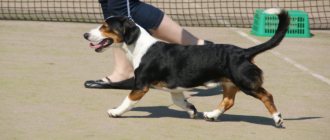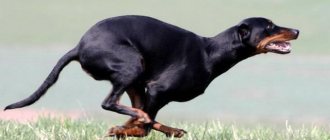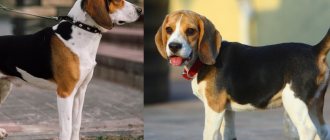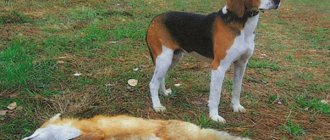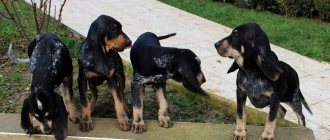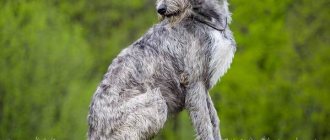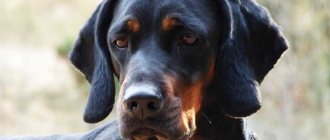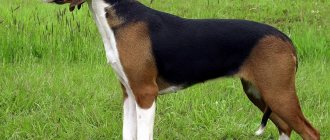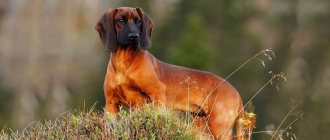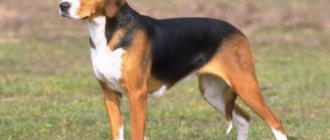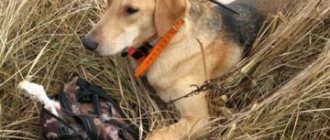The Alpine Dachshound or Alpine Dachsbracke (German: alpenländische dachsbracke; English: Alpine Dachsbracke) is a relatively modern breed of hunting dog, created in the late 19th century. It was bred to track wounded deer, as well as wild boars, hares and foxes. The breed is not widespread, mainly found in Austria and Germany. He makes a good companion, although he is primarily a hunter and is therefore kept mainly by hunters. Most Alpine Dachshunds are excellent with children and get along well with dogs and other pets, although they may exhibit the strong prey drive that is typical of many dogs.
Breed dossier
- Country of origin:
Austria - Classification:
Group 6: Hounds and related breedsSection 2: Hounds
- Training:
Needs firm but patient training. - Color:
Black and Tan Dachshund Bracket: Black with rusty red markings.Brown dachshund with lighter tan markings, brown nose.
Red Dachshund Bracket: Fawn, rusty red, rusty yellow with lighter tan markings.
Piebald dachshund Brack (Westphalian). All acceptable colors for red Brackets in combination with white. Markings are located on the forehead, muzzle, legs and chest.
Red Brackets are allowed to have white only in the form of a thin blaze on the back of the nose, a white thin stripe on the throat or on the chest in the form of a collar, on the belly, fingers and lower legs. In brown and red braccas, a little black is allowed on the muzzle, above the eyes, along the edges of the ears, on the cheeks, along the ridge, and partly on the tail.
- Dimensions.
Height: males 37-38 cm, females 36-37 cm. Weight 15-18 kg. - General impression:
A medium-sized dog, slightly similar in build to a dachshund, with short legs and a long body. - Usage.
It is bred exclusively for hunting. The breed is officially recognized as a blood trail hound, although it belongs to the Bracco group, that is, baiting dogs, and is therefore considered a multi-purpose hunting dog. Dogs of this breed are excellent hunters of hare, fox, deer and wild boar; their excellent sense of smell allows this dog to sense prey at a great distance. In addition, she is good at fetching game birds.The dachshund Bracket is not hampered by difficult terrain; he is energetic and tireless in the mountains. The Dachshund Bracket is a dog adapted to the difficult conditions of mountain hunting grounds, which chases the animal calmly and slowly, with a voice. A dog with good instincts and innate malice towards the beast. It is unusually hardy, readily works in all weather conditions, and easily copes with the task, both on the plain and in mountainous areas.
This dog is mainly used for working on a blood trail, although the Alpine dachshund hound is capable of following even a “cold” trail. During the hunt, it does not stray far from its owner.
- Exercise:
Space and exercise required. He will never refuse to hunt. - Character:
The Alpine Dachshund has a balanced character. She is calm, alert, obedient. A persistent, agile dog with enormous endurance. Restrained, proud and with an independent disposition.Tenacious and warlike on the hunt, the dachshund brakk is affectionate and devoted to its owner.
- Content:
Dogs are suitable for hunters who have the opportunity to regularly use them for hunting and provide them with appropriate loads. - Grooming:
It is necessary to brush your dog's coat regularly. Wash only when absolutely necessary. Keep your ears clean and trim your nails regularly. - Accommodation:
Alpine dachshunds are distinguished by excessive harshness, not only in relation to other animals, but sometimes also to humans. They should be handled with extreme caution, although they are very friendly when properly trained. She warmly welcomes your guests and communicates with them: after all, her well-developed hunting instinct operates only on the hunt, and home is home, and here she is completely different. Usually gets used to other pets quickly. Treats strangers with caution. May show aggression towards relatives. - Diseases:
Having good immunity, the Alpine Dachshund rarely gets sick. Urinary stones and paralysis may occur. - Diet:
Unpretentious in food. - Life expectancy:
10-12 years.
Health
Due to the rarity of the breed, there have been no reported cases of birth defects in the United States. This does not mean that there are none, only that none have been registered with the major canine health registries in the English-speaking world.
However, with a unique skeletal structure that includes a fairly long body and spine with a short rib cage, they may be at risk for back injuries. The most common injury affecting elongated breeds is intervertebral disc disease; a condition in which the intervertebral discs become damaged, which can lead to severe pain or paralysis.
The risk of developing this condition is known to increase due to obesity, jumping, rough handling or intense exercise, which puts more stress on the vertebrae.
As with any purchase of a purebred dog, it is important that the animal is purchased from a reputable kennel that is willing to provide medical records, certificates and photographs of past litters.
History of origin of the breed
The breed was bred in Austria in the middle of the 19th century on the basis of such breeds as dachshund hounds, Segurian Bracques, and it is also possible that another ancestor of the Alpine dachshund Braccus was the long-legged Braccus. Chasing deer, foxes and rabbits in the high Alps required a dog that was strong and resilient, standing on its feet, and at the same time larger than most dachshund hounds. Therefore, Austrian hunters, based on local dachshund hounds, bred the larger Austrian Bracket.
This dog is not yet known to Russian hunters and is not very common in other countries besides Austria.
It was recognized as an independent breed in 1975.
Breed standard and description
The Austrian Bracket is a medium-sized dog, athletic and robust with light, fine bones and powerful muscles. A flexible, strong, lean body with a long back, clearly defined withers, a wide, voluminous sternum, a slightly arched loin and a moderately tucked belly line.
- The height of this baby is very small - 35 - 42 cm, and it weighs up to 15 - 18 kg.
- Head/muzzle. Small in size relative to the size of the body, the muzzle is narrower than the skull, very slightly pointed, approximately equal in length to the skull.
- The coat of this hound is dense and thick, mostly fawn in color - reddish or red with blackening at the tips of the hair and darkening on the ears.
- Body build: strong, elongated, stomach well tucked, ribs convex. The neck is wide, muscular, without dewlap. The back is straight, wide, long, the croup is rounded.
- Strong, robust muzzle with a straight bridge of the nose. The large nose is pigmented black.
- The tail is of medium length - saber-shaped, typical of a hound, set just below the level of the back. Usually lowered, raised only when searching for prey.
- Straight and strong, muscular and developed limbs are spaced widely. Oval, strong paws with well-knit toes, hard, black claws and large elastic pads.
Psychological picture
This dog has a balanced character: he follows the trail of the game leisurely, without nervousness, occasionally raising his voice. But besides the fact that this Alpine Bracket is a talented hunter, he has many other advantages.
He is a wonderful friend and a good companion, both for quiet and long active walks. He will warmly welcome your guests and communicate with them: after all, his hunting instinct “works” only on the hunt, and a home is a home, and here it is completely different.
Content
It is advisable to keep a hound in a spacious country house surrounded by natural landscapes. The dog needs daily long walks in the forest or park. Therefore, in the conditions of city streets, the hound will not be able to fully realize its hunting skills and the need for active training. Once you become a dog owner, you need to be prepared to devote a sufficient amount of time to walks. The dachshund hound will happily accompany its owner on a morning jog or bike ride.
Video
Training
stubbornness and independence during training . In this case, the owner should not raise his voice at the dog or punish it. This can lead to the dog becoming angry and resentful. To get good training results, you need to have a lot of patience and persistence in following every command until the dog recognizes its owner as a leader. Don't forget about regular outdoor games with a ball, stick, or disc. Such activities will help win the dog’s favor and complete obedience.
Where to buy a puppy?
Since there are very few kennels of this herding breed in Russia and Europe, finding the desired puppy will not be easy. It is best to contact kennel clubs, where they will help you in your search. Also a good option is visiting exhibitions. As a rule, dogs with a pedigree perform there. Once you see a representative of the breed, you can approach the owner and find out if he has puppies (or, perhaps, are expected).
Finding a puppy online is a lottery. Unfortunately, not all owners are conscientious, and buying secondhand is a very dangerous business.
The cost of a Savoy Shepherd puppy is $200-400. You need to understand that the breed has not yet received recognition from the world canine community, so there is no need to talk about compliance with the breed standard or excellent pedigree.
You can get to know each other better and watch the Alpine Shepherd at work in the following video.
Character
This breed has an excellent character. It is easy for them to get along with every member of the household, however, they obey only the one whom they have appointed leader. They love children very much, even small ones, and take great care of them. They can even get along with a cat, but only with the one that lives in the house with them. The Alpine Shepherd does not tend to rush at people, however, it will greet strangers or people they barely know with suspicion.
Another distinctive property of the animal is its lightning-fast reaction. The Alpine Shepherd is always vigilant, attentive, and reacts to changes in the situation extremely quickly. Even in those moments when the dog is supposedly relaxed and not paying attention to what is happening, it is alert and ready to react at any moment.
How to train hounds
Training hounds is called training. Before starting the hunt, the hunter makes sure that the dog meets all the criteria:
- malice towards the beast;
- good voice;
- strong instinct;
- high speed and endurance.
The race develops:
- search ability;
- orientation;
- the ability not to lose track;
- the ability to listen to the hunter and his commands;
- ability to work in a group, in a pack or alone.
The hunt is carried out in early spring and late autumn before the hunting season. The best age for a dog is one year. By this time, the dog has learned all the basic commands. Before training, be sure to train the dog so that it is in sports shape. They do it on an empty stomach to make it more vicious. Only second-year students are allowed to paddle in the snow.
The pressure is produced from the year
During the first lessons, the dog gets to know the area. At first, the hunt is carried out in the morning in places where there are definitely animals (hot on the trail). The most important thing is to guide and encourage the dog so that it understands that it is doing everything right. During the hunt, the dogs themselves show their hunter instinct. But there are also dogs that are unsuitable for hunting: they are constantly distracted, silently following the scent, or too noisy.
Dog training is done in an experienced pack with experienced hunters
This is important so that the “youth” understand exactly how to act when hunting
Hunting dogs are, for the most part, excellent companions. But at the same time, these are very active and energetic dogs that require equally active owners. You can only get a hound if you have enough time for the dog.
Distinctive features of hounds
The first mentions of hounds were found in ancient Egyptian frescoes. At that time these dogs were larger than they are now. Hunting dogs include hounds, greyhounds and pointers. The gonchak works in such a way as to drive the victim under a person’s weapon. Greyhounds only catch visible prey and are distinguished by good speed over short distances. The cops track the victim, and when they find it, they give a signal to the hunter.
External description of the hounds:
- drooping ears;
- straight bridge of the nose;
- lips fit tightly to jaws;
- large head with a rounding near the neck;
- straight back;
- wide chest;
- strong paws;
- short, straight coat.
Also, representatives of hound breeds have the following qualities:
- endurance;
- persistence;
- ability to pursue prey for several hours;
- keen sense of smell;
- high speed of movement;
- loud ringing bark as a signal for the owner.
Hound dog breeds are very popular among hunters. The Gonchak is hunter-oriented and amenable to training and training. It is easy to control while hunting. These dogs quickly find a common language with representatives of their breed:
- work harmoniously in a pack;
- walk with a bow;
- reorganize together;
- take the correct position.
https://youtube.com/watch?v=bxg9EXYM6O8
Raising an Alpine Dachshund Bracket
As a born hunter, representatives of the breed have a fairly high level of animal feeding. This can be dangerous for owners of small pets. Therefore, it is not recommended to keep these dogs in homes that already have cats, rabbits, birds or other animals. They can easily harm other pets. This natural tendency to hunt can also cause the Alpine Dachshund to actively snare neighbors' small pets.
At home, this breed is considered moderately active or prone to a sedentary lifestyle. Therefore, although it is suitable for an apartment or small house, it requires a lot of attention to prevent obesity. This problem can be especially dangerous and cause a variety of serious health problems in the short, long-haired, short-haired Alpine dachshund. Obesity is also known to be a serious problem among dachshund owners - their ancestors.
As you would expect from a hunting breed, the Alpine Dachshund is very intelligent. This makes training fairly easy, although you need to be careful with the breed's independent or stubborn nature. This breed responds well to positive reinforcement such as treats and praise. Animals need to be trained firmly, gently and positively. They can learn quickly and act loyal and obedient. Consistency in training is key to better training your dog.
Nutrition
The Drever is a small dog, so it can consume 200-220 g of meat products per day, including beef, chicken, lamb and offal. Fatty pork and other high-fat foods that should not be present in your dog's diet should be avoided. Drever needs a variety of nutrients found in different grains and vegetables, typically oat and wheat.
In the spring and early summer, add finely chopped greens to the dog soup - nettle, sorrel, etc. It makes sense to add synthetic vitamin supplements, which are available in drops or capsules, which can improve the well-being and appearance of the dog's coat.
Varieties of dachshunds
There are three size varieties of dachshunds:
- standard _ Weight - about 9 kg, chest circumference - from 35 cm;
- dwarf _ Weight is from 4 to 5.5 kg, chest circumference is 30-35 cm;
- rabbit _ Average weight - 3.5-4 kg, chest circumference - up to 30 cm.
Based on their coat type, dachshunds are also divided into 3 varieties:
- smooth- haired The coat is very short, close to the body, but should not be rough;
- long- haired On the head and muzzle the hair is close-fitting and very short. On the ears, limbs and body the hair is much longer;
- - haired The fur feels like wire, not too long, thick and dense, forming a mustache, beard and eyebrows on the face.
Chongqing care
Chongqing does not cause any problems with maintenance. It can be kept both in an apartment (due to its small size and small amount of wool) and outside in an enclosure (providing a place for shelter from heat and frost).
The area where your pet is kept must be kept clean. The dog is prone to dermatitis, so its bed should be washed regularly.
Some rules should be followed:
- Grooming involves brushing. It is enough to carry out the procedure once every 2 weeks. Its main purpose is to add shine to the coat, because Chongqing cats practically do not shed. At the end of combing, the wool is rubbed in the direction of hair growth with a piece of suede or a soft cloth.
- Bathing should be done as rarely as possible - 2 times a year will be enough. Dirt is removed with a damp cloth, and paws are wiped in the same way after a walk. Chongqing skin is very sensitive, so when bathing is necessary, choose hypoallergenic shampoos.
- Nails are trimmed only if they wear down naturally during walks.
- Eye and ear care is no different from other breeds. When they become dirty, wipe them with a damp cotton swab.
Chinese bulldogs are quite active animals. Therefore, in order not to observe the destructive signs of lack of physical activity in the house, they need to be walked for at least an hour twice a day. They can walk on a leash, but these pets need time and a place to release energy, and every day. Therefore, Chongqing is suitable for people and families leading an active lifestyle. With a lack of exercise, the dog becomes irritable and aggressive.
Chongqing needs daily exercise
Nutrition
It is recommended to feed Chongqing dogs only with natural food. It should be based on meat - turkey, rabbit, beef, horse meat. You can also give raw, but frozen meat (previously keep it in the freezer for 2-3 days). But offal (liver, heart, lungs, kidneys) needs to be cooked.
You should also add to your diet:
- lean boiled fish without bones;
- fermented milk products (cottage cheese, kefir);
- grains (buckwheat, rice);
- chicken eggs (1–2 per week);
- vegetables (fresh and stewed) - pumpkin, zucchini, carrots, beets;
- greenery.
Dogs are given bones (except tubular ones) infrequently, and puppies don’t need them at all until all their permanent teeth have formed. it is better to replace them with special treats in the form of dry pressed veins.
The list of prohibited foods does not differ from that for dogs of other breeds. Prohibited:
- food from the master's table;
- fatty, salty, seasoned with spices;
- beans, peas and cabbage;
- potatoes and corn;
- sweets and baked goods.
Adults are fed 2-3 times a day, puppies - up to 6 times. Clean water must be freely available at all times.
Like all dogs on a natural diet, Chongqing dogs need to take care of taking special vitamin and mineral complexes on the recommendation of a veterinarian.
Character
In a family, among all household members, the bandog intuitively determines its owner, and he becomes the strongest and most strong-willed person. This does not mean that the dog will not obey the rest of the family, but with some leniency and subject to proper upbringing.
The American Bandog has an amazing feature. He is able to guess a person’s intentions by movements, timbre of voice, and facial expressions. If a person is aggressive, came with bad intentions, the bendoggy will attack immediately, without growling, barking, in a word, without warning. This dog is an ideal watchman and bodyguard. With just its appearance it can scare away robbers and other intruders.
Bandog usually does not show his mood; he keeps his emotions to himself. Therefore, it can ingratiate itself with the owner and fawn on him in very rare cases. Although each representative of the breed is individual in his own way, and his behavior largely depends on his upbringing.
Bandog is not recommended for families with children. The dog is loyal to kids, but no more. He will not tolerate their pranks; children's screams, laughter, and running around can irritate the dog. Even if the pet is in a playful mood, games should not be allowed between a large fighting dog and a small child. An animal may inadvertently cause harm.
He behaves condescendingly with other pets. He doesn’t particularly strive for friendly relations, but he doesn’t start fights over trifles either.
Workout
Thanks to his innate intelligence, observation and agility, the drever perfectly perceives everything said and shown to him during training. Training must be done from a very early age and regularly, so you can achieve good results very quickly. Make your dog overcome various obstacles, this will help develop character traits such as courage and endurance. When training a puppy, you need to be doubly careful so as not to in any way cause physical or mental trauma to him, which can leave a serious imprint on the dog’s character. Do not overtire your puppy.
